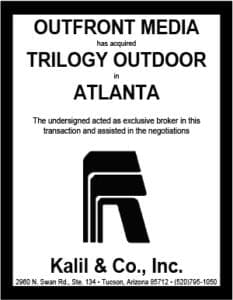
By Richard Rothfelder, Rothfelder & Falick
By now, most know the facts: On April 21, 2022, the U.S. Supreme Court in a 6 to 3 decision reversed the Fifth Circuit Court of Appeals’ decision in City of Austin vs Reagan National Advertising, which held the Austin Sign Code violative of the First Amendment for distinguishing between on-premise and off-premise signs. Justice Sotomayor, writing for the Majority, and joined by Chief Justice Roberts, and Justices Breyer, Kagan, Kavanaugh, and Alit0 (who concurred in the judgment, but dissented in part), said the Court of Appeals went too far in finding the Austin Code content based and warranting a strict scrutiny review, merely because the sign inspector has to read the sign’s message to regulate it. Instead, the Supreme Court requires content based regulations to be those that discriminate based on “the topic discussed or the idea or message expressed.” And, the Court went on, the City’s on-premise/off-premise distinction merely informs the sign’s relative location, and it is therefore more like ordinary time, place, or manner restrictions, which don’t require application of strict scrutiny. Therefore, the holding of the Court of Appeals that the Austin Code is unconstitutional was reversed, and the case was remanded back to the lower court for further evaluation and proceedings, including under intermediate scrutiny.
By way of background, Reagan and Lamar Outdoor had applied to the City of Austin to convert several of their static billboards to digitally illuminated and changing displays. Austin allowed digital displays for on-premise signs, however, the City prohibited such digitals for off-premise signs, like Reagan’s and Lamar’s billboards. Austin denied the digital conversion permits, so Reagan and Lamar sued.
After Reagan and Lamar lost at the trial court and appealed, the Fifth Circuit relied on the Supreme Court’s 2015 seminal precedent in Reed vs Town of Gilbert in holding on August 25, 2020 that the Austin Code was content based, warranted strict scrutiny review, and violated the First Amendment’s protection of Free Speech. In so holding, the Fifth Circuit found the on-premise/off-premise distinction under the Austin Code, like the different treatment accorded to temporary church signs in Reed, effectively required one to read the message displayed on the sign to determine if the goods, services, or businesses it advertised or identified were located or offered on or off of the same premises where the sign was situated, and thus, permitted or prohibited.
The Majority on appeal to the Supreme Court noted that “unlike the sign code at issue in Reed, however, the provisions at issue here do not single out any topic or subject matter for differential treatment.” It went on to explain “rather, the City’s provisions distinguish based on location: A given sign is treated differently based solely on whether it is located on the same premises as the thing being discussed or not.” Therefore, The Court concluded “the on-/off-premise distinction is therefore similar to ordinary time, place, or manner restrictions. Reed does not require the application of strict scrutiny to this kind of location-based regulation.” Therefore, to the extent a bright line test can be identified for when the Supreme Court will consider a sign regulation content based warranting strict scrutiny, the simple inquiry previously imposed by the Fifth Circuit to read the message on the sign to determine whether its permitted or prohibited, is gone. Instead, the Court has added the requirement that such a message must target specific topics, viewpoints, or subject matter that are accorded differential treatment under the sign regulations to justify the highest level of scrutiny for First Amendment purposes.
What does this mean in practice? To start with, the Court’s decision means the mere fact that a sign regulation provides different treatment for traditionally defined on-premise and off-premise signs, does not automatically render such a regulation in violation of the First Amendment. Indeed, the Court seems quite aware of the potentially profound impact of the Firth Circuit’s decision on billboard regulation nationally and historically, as it literally begins the opinion by reciting that “like thousands of jurisdictions around the country, the City of Austin, Texas, regulates signs that advertise things that are not located on the same premises as the sign.” It later notes that “for the last SO-plus years, federal, state, and local jurisdictions have repeatedly relied upon on-/off-premises distinctions to address the distinct safety and esthetic challenges posed by billboards and other methods of outdoor advertising.” The Court then concludes “the unbroken tradition of on-/off-premise distinctions counsels against the adoption of Reagan’s novel rule.” Therefore, just because the Austin Code allows digital illumination for on-premise signs, while prohibiting it for off-premise, does not render the Code unconstitutional. And, much more broadly, the decision means that the Federal Highway Beautification Act, as well as the numerous State HBAs, all of which utilize the traditionally defined distinction for different treatment of on and off-premise signs are likely no longer vulnerable to constitutional challenge.
So, what’s next? For Reagan, as well as Lamar (which didn’t participate in the litigation at the Supreme Court level), the permits they had sought for conversion of their static signs to digital displays will likely not be granted, at least not without further litigation. Specifically, the Court left open a couple avenues by remanding the case back to the trial court for further proceedings. First, while holding the Austin Code was facially content neutral despite the on-premise/off premise distinction, the Court noted sign regulations could still be content based and unconstitutional if there was evidence of an impermissible purpose or justification underpinning the regulation. Second, a sign regulation may still be held unconstitutional under the less onerous review standard of “intermediate scrutiny”, which requires a restriction on speech to be “narrowly tailored to serve a significant governmental interest,” in order to survive a constitutional challenge. Both of these issues would have to be resolved through a consideration of the evidence at a trial on the merits on remand.
Once again, more broadly for the entire billboard industry, the decision probably also means that lawyers have one less tool in their litigation belt to challenge sign regulations solely based on the on-premise/off-premise distinction. Previously, the experienced billboard attorney would urge a “Reed Challenge” in a permit denial or other regulatory dispute with a state or city that relied on the traditional definition for on and off-premise signs for the differentiation of their sign regulations. Now, after the Supreme Court’s decision, the lawyer will have to satisfy the newly articulated test of whether the message also targets specific topics, viewpoints, or subject matter to violate the First Amendment. That’s a heavier burden, for Reagan and any other billboard company challenging discriminatory sign codes.
[wpforms id=”9787″]
Paid Advertisement

















